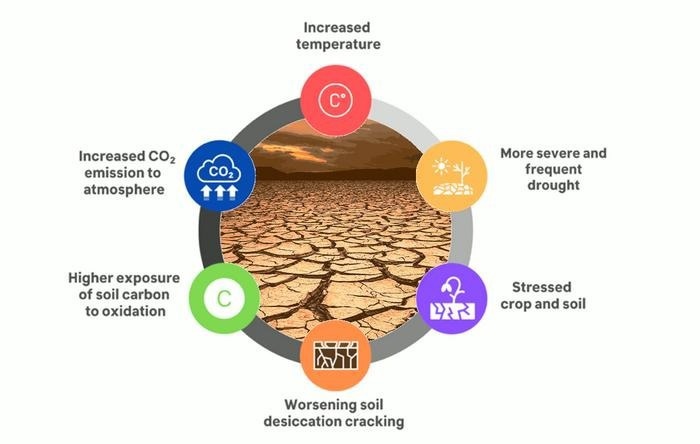Numerous variables affect the accuracy of climate models, including greenhouse gas emissions from transportation and industrial processes, “emissions” from farm animals, urbanization and forest loss, and solar reflection off snow and ground cover. Volcanic eruptions are one example of a natural phenomenon included in models.
 Cycle of drought, drying and cracking soil, and ground carbon release creates and amplified feedback loop that has not been accounted for in most models of climate change. Image Credit: Farshid Vahedifard, Tufts University
Cycle of drought, drying and cracking soil, and ground carbon release creates and amplified feedback loop that has not been accounted for in most models of climate change. Image Credit: Farshid Vahedifard, Tufts University
Some natural processes have been neglected. Farshid Vahedifard, Professor and Louis Berger Chair in civil and environmental engineering, highlights a significant one situated directly beneath, spanning most of the planet's surface above water.
Around 80% of Earth’s carbon is stored in soil, according to a study by Vahedifard published in Environmental Research Letters. However, as cycles and droughts worsen in some areas, this vital reservoir is fizzling and disintegrating, releasing even more greenhouse gases into the atmosphere, including carbon dioxide. It may generate an enhanced feedback loop that would cause climate change to accelerate far faster than currently anticipated.
This process has not been sufficiently evaluated in the existing literature or incorporated into models. If we don’t consider the interplay of drought, soil desiccation cracking, and CO2 emissions, that could result in significant inaccuracies when modeling and predicting climate change. There are other repercussions as well. Poorer soil health can lead to reduced photosynthesis and lower carbon dioxide uptake, and it can compromise the structural integrity of earthen dams that protect against floods.
Farshid Vahedifard, Professor and Louis Berger Chair, Civil and Environmental Engineering, Tufts University
According to Vahedifard, models of climate change may not have taken into consideration all of the additional amplifying feedback loops. They include the melting of sea ice and the exposure of darker ocean surfaces, which are more susceptible to solar heat absorption.
Warm, dry weather causes more wildfires, which release a lot of carbon dioxide into the atmosphere, making the weather hotter and drier and thus more fire-friendly.
The melting of permafrost in the Arctic and sub-Arctic contributes to an additional amplified feedback loop by releasing carbon dioxide into the atmosphere and increasing global temperatures, which in turn causes more permafrost to melt.
However, alterations in soil due to drought could be equally, if not more, impactful than any of those factors. Drought, characterized by prolonged periods of low soil moisture content and high temperatures, causes fissures in fine-grained soils, often extending meters below the surface.
These cracks lead to heightened exposure to air, elevated microbial activity, decomposition of organic matter, the release of carbon dioxide, and depletion of nutrients critical for sustaining plant growth, ultimately diminishing carbon dioxide sequestration capabilities.
Much older, stable, and shielded carbon reserves are exposed by the deep fissures. Air seeps into the soil, causing other greenhouse gases, such as nitrous oxide, to be released from organic matter more quickly in addition to carbon dioxide.
The decreased moisture and increased air exposure also have an impact on small animals that aid in soil turning, such as millipedes and earthworms, making them less able to actively participate in the cycling of nutrients and preservation of soil structure. Thus, there is a greater chance of soil aeration and cracking.
The amplifying effect of soil carbon feedback loops and its interactions with other loops could carry us across tipping points and lead to even more severe and permanent shifts in climate.
Farshid Vahedifard, Professor and Louis Berger Chair, Civil and Environmental Engineering, Tufts University
He added that government agencies and policymakers need to promote sustainable land use, “which can include adoption of precision irrigation techniques and water conservation practices, and use of drought tolerant crops. Organic fertilizers and compost can enhance soil organic matter content and improve soil water-holding capacity. Of course, this can only help if it’s part of a comprehensive effort to reduce greenhouse gas emissions from all human activity.”
Journal Reference:
Vahedifard, F., et al., (2024) Amplifying feedback loop between drought, soil desiccation cracking, and greenhouse gas emissions. Environmental Research Letters. doi/10.1088/1748-9326/ad2c23